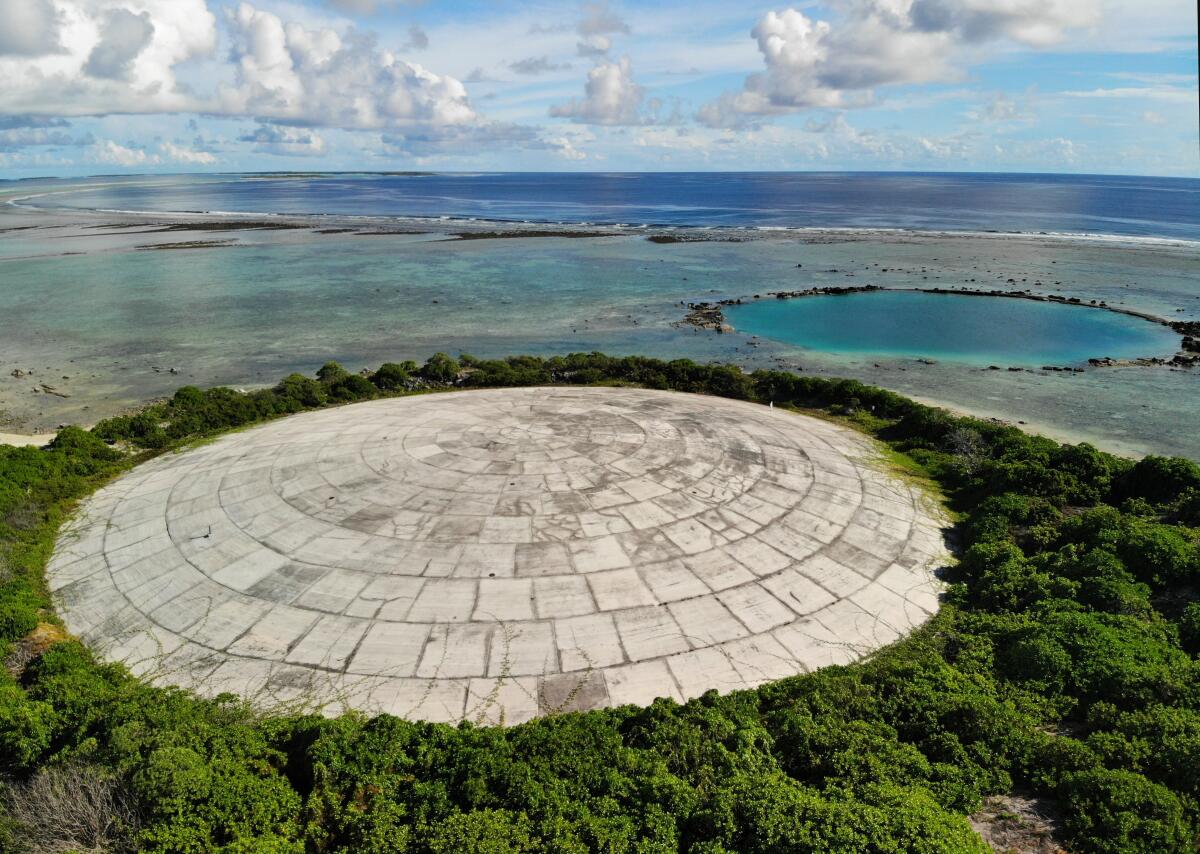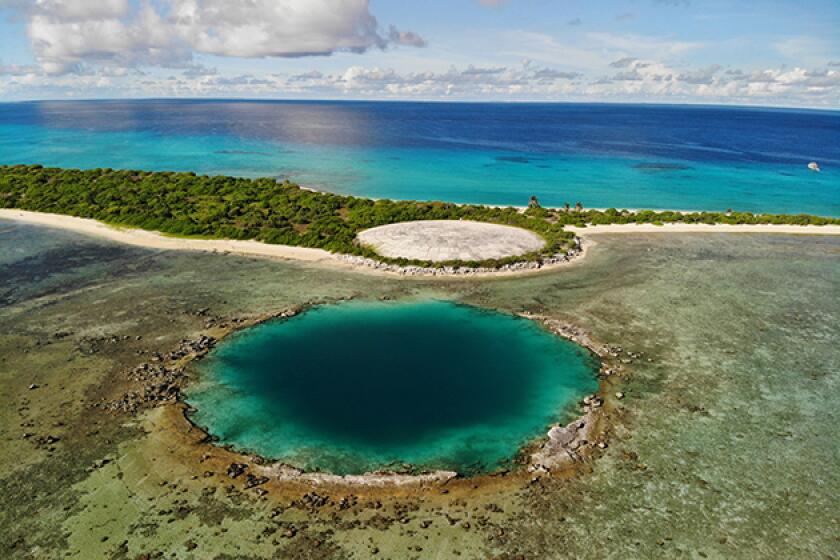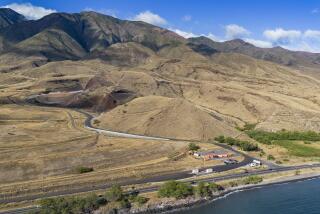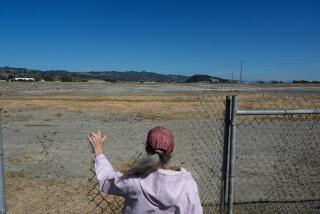New U.S. law requires probe of Marshall Islands nuclear dump threatened by rising seas

- Share via
Congress is demanding that the Department of Energy investigate an aging, cracking U.S. nuclear waste dump threatened by climate change and rising seas in the Marshall Islands.
As part of the new National Defense Authorization Act, signed last week by President Trump, the energy agency must submit a report by mid-June on the risks that Runit Dome poses to the people, environment and wildlife of Enewetak lagoon — the site of 44 nuclear bomb detonations during the Cold War.
It must also include an assessment of how climate change could affect the site, although the term “climate change” was dropped as the bill moved through the Senate Armed Services Committee, which is chaired by Oklahoma’s James M. Inhofe, one of Congress’ most outspoken climate change skeptics.
According to the law, the energy agency must submit a report that includes an “assessment of how rising sea levels might affect the dome.”
The investigation was applauded by at least one representative of the Marshall Islands, which continues to contend with the radioactive legacy of U.S. nuclear testing. The island nation sits in a remote part of the central Pacific, 5,000 miles southwest of Los Angeles.
“We are encouraged by the inclusion in the [act] of the requirement,” said Rhea Moss-Christian, chairwoman of the Marshall Islands’ National Nuclear Commission, a three-person government panel that reports directly to the president on nuclear issues in the islands.
She said the original language for the bill, which was introduced by U.S. Rep. Tulsi Gabbard (D-Hawaii), required a plan for relocating the waste, as well as an assessment of how local food is affected by the dome.
Moss-Christian said her committee was disappointed these elements were not included in the final version, which the president signed. But she added that she was hopeful the new law “will yield useful results to better inform our decision making.”
There was no immediate response from the Lawrence Livermore National Laboratory, which the Energy Department has assigned to monitor Runit Dome and the radiation leaking from it.
The waste site, known alternatively as the Tomb, or simply the Dome, holds more than 3.1 million cubic feet — or 35 Olympic-size swimming pools — of U.S.-produced radioactive soil and debris, including lethal amounts of plutonium.
Nowhere else has the United States saddled another country with so much of its nuclear waste, a product of its Cold War atomic testing program.
With climate change and rising seas, the U.S. is about to face a reckoning for the toxic nuclear legacy we buried — and forgot — in the Marshall Islands.
From 1946 to 1958, the United States detonated 67 nuclear bombs on, in and above the Marshall Islands — vaporizing whole islands, carving craters into its shallow lagoons and exiling hundreds of people from their homes.
Department of Energy contractors admitted last spring that the dome is vulnerable to rising sea levels and storm waves, and is leaking into Enewetak lagoon. Studies have shown elevated levels of radioactive contamination in local seafood, including giant clams.
This year, the Los Angeles Times published an investigation of the dome and Enewetak lagoon, revealing that it was the location of at least a dozen biological weapons tests and also the repository for 130 tons of soil from an irradiated Nevada testing site.
The investigation also documented decades of U.S. deception in the Marshall Islands, including the withholding of critical information about people’s exposure to radiation. Thousands of documents about the testing program are still classified, leaving many Marshallese distrustful and unsure about the full impact of U.S. weapons testing there.
For decades, the Marshallese have expressed alarm about Runit Dome and its potential risk to the 650 inhabitants of Enewetak lagoon, who fish and harvest seafood from the lagoon, and collect coconut, pandanus, coconut crabs and breadfruit from islands in the atoll.
In July, a team led by Emlyn Hughes of Columbia University’s K=1 Project — a program designed to investigate nuclear weapons issues across the globe — found elevated levels of radiation on Runit Island.
According to their research, levels were higher than those found emanating from soils near the sites of the Chernobyl meltdown and the Fukushima disaster.
“At last the U.S. government seems to be getting serious about addressing this serious environmental issue that it created decades ago,” said Michael Gerrard, a legal scholar at Columbia University’s law school. “This is a very welcome development.”
It also comes soon after the U.S. announced its intention to extend its Compact of Free Association with the Marshall Islands, which was set to expire in 2023.
The compact, which was initially signed in 1986, provides the Marshallese government with funding, allows its citizens to work and travel in the United States without visas, and provides the U.S. government with a strategic military base on Kwajalein Atoll — the center for U.S. intercontinental ballistic missile testing.
Recently, the United States and another world power have been vying for influence over the Marshall Islands, because of its strategic position in the Pacific.
As China has increased its financial and military presence in the region, the United States has been losing footing with formerly staunch allies, including Kiribati and the Solomon Islands.
Many Marshallese argue the U.S. has not done enough to address its history of radioactive contamination in the islands or help the nation deal with the growing assaults of climate change.
A recent general election in the Marshall Islands could determine whether the government develops a closer relationship with China, which has been courting the island nation. The results are still not official, but New Zealand media reported that an opposition slate of candidates is ahead and could triumph over incumbent President Hilda Heine, resulting in policies more favorable to China.
More to Read
Sign up for Essential California
The most important California stories and recommendations in your inbox every morning.
You may occasionally receive promotional content from the Los Angeles Times.












